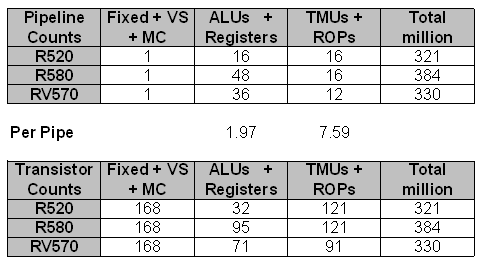Jawed
Legend

Previously we've had an estimate of 2M transistors per ALU pipeline (including its associated register file) for R5xx GPUs.
With RV570 it seems to me we can get an estimate of the number of transistors in the TMU and ROP pipelines, jointly. About 8M transistors.
That then leaves a baseline of about 168M transistors for the remainder of the die: fixed function pipelines, vertex shader pipelines, memory controller, ring bus, PCI Express interface, AVIVO, etc.
There's got to be some error in here, as I can't account for the setup engine architecture. The setup engine, being between VS and PS, could scale depending upon the number of PS pipelines (16 in R520 and R580, 12 in RV570). There'll be other errors, I'm sure, simply due to various scaling factors and revisions over the lifetime of R5xx.
One notable revision is the Fetch 4 hardware in the TMUs, something that's missing from R520.
Jawed

